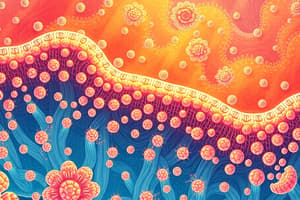Podcast
Questions and Answers
Which of the following factors would decrease the rate of diffusion across a plasma membrane?
Which of the following factors would decrease the rate of diffusion across a plasma membrane?
- Decreased concentration gradient (correct)
- Smaller molecular size
- Increased temperature
- Larger surface area of the membrane
A plant cell is placed in a solution where the concentration of solutes is lower outside the cell than inside. Which of the following will occur?
A plant cell is placed in a solution where the concentration of solutes is lower outside the cell than inside. Which of the following will occur?
- The cell will undergo lysis.
- The cell will become flaccid due to water loss.
- The cell will undergo crenation.
- The cell will experience turgor pressure. (correct)
Which process primarily relies on the movement of molecules from an area of high concentration to an area of low concentration?
Which process primarily relies on the movement of molecules from an area of high concentration to an area of low concentration?
- Osmosis
- Endocytosis
- Active transport
- Diffusion (correct)
Which characteristic of phospholipids is MOST responsible for the plasma membrane's selective permeability?
Which characteristic of phospholipids is MOST responsible for the plasma membrane's selective permeability?
What is the MOST likely predicted consequence if a cell membrane were composed primarily of saturated fatty acids?
What is the MOST likely predicted consequence if a cell membrane were composed primarily of saturated fatty acids?
What characteristic of a plasma membrane allows water to diffuse across it, but blocks the movement of solute molecules?
What characteristic of a plasma membrane allows water to diffuse across it, but blocks the movement of solute molecules?
What type of transport requires the use of ATP?
What type of transport requires the use of ATP?
Within the fluid mosaic model of the plasma membrane, what is the primary role of integral proteins?
Within the fluid mosaic model of the plasma membrane, what is the primary role of integral proteins?
An animal cell is placed in a hypertonic solution. What is the most likely outcome for the cell?
An animal cell is placed in a hypertonic solution. What is the most likely outcome for the cell?
How does cholesterol contribute to the structure and function of the plasma membrane?
How does cholesterol contribute to the structure and function of the plasma membrane?
A protein that spans the plasma membrane is called what?
A protein that spans the plasma membrane is called what?
Which of the following best describes facilitated diffusion?
Which of the following best describes facilitated diffusion?
Where are peripheral proteins located?
Where are peripheral proteins located?
Which of the following is required for facilitated diffusion to occur?
Which of the following is required for facilitated diffusion to occur?
Which of the following is NOT a component of the plasma membrane?
Which of the following is NOT a component of the plasma membrane?
What is the region between the plasma membrane and the nuclear envelope called?
What is the region between the plasma membrane and the nuclear envelope called?
Why are hypotonic solutions considered ideal for organisms with cell walls?
Why are hypotonic solutions considered ideal for organisms with cell walls?
Which of the following is a defining characteristic of active transport?
Which of the following is a defining characteristic of active transport?
How does active transport contribute to a cell's ability to perform work?
How does active transport contribute to a cell's ability to perform work?
Electrochemical gradients, crucial for nerve signal transmission and muscle contraction, are a direct result of what cellular process?
Electrochemical gradients, crucial for nerve signal transmission and muscle contraction, are a direct result of what cellular process?
What is the primary distinction between primary and secondary active transport?
What is the primary distinction between primary and secondary active transport?
In secondary active transport, how does the movement of a molecule against its concentration gradient occur?
In secondary active transport, how does the movement of a molecule against its concentration gradient occur?
What is the key difference between phagocytosis and pinocytosis?
What is the key difference between phagocytosis and pinocytosis?
During exocytosis, what cellular structure facilitates the release of substances from the cell?
During exocytosis, what cellular structure facilitates the release of substances from the cell?
Flashcards
Plasma Membrane
Plasma Membrane
Boundary that separates the cell's interior from the external environment.
Cytoplasm
Cytoplasm
The entire region between the plasma membrane and the nuclear envelope, including organelles and cytosol.
Fluid Mosaic Model
Fluid Mosaic Model
Describes the plasma membrane as a fluid lipid bilayer with proteins embedded within or attached to it.
Integral Membrane Proteins
Integral Membrane Proteins
Signup and view all the flashcards
Phospholipid Bilayer
Phospholipid Bilayer
Signup and view all the flashcards
Cholesterol in Membranes
Cholesterol in Membranes
Signup and view all the flashcards
Integral Proteins
Integral Proteins
Signup and view all the flashcards
Peripheral Proteins
Peripheral Proteins
Signup and view all the flashcards
Diffusion
Diffusion
Signup and view all the flashcards
Passive Transport
Passive Transport
Signup and view all the flashcards
Active Transport
Active Transport
Signup and view all the flashcards
Facilitated Diffusion
Facilitated Diffusion
Signup and view all the flashcards
Osmosis
Osmosis
Signup and view all the flashcards
Hypotonic
Hypotonic
Signup and view all the flashcards
Isotonic
Isotonic
Signup and view all the flashcards
Hypertonic
Hypertonic
Signup and view all the flashcards
Hypotonic Solution
Hypotonic Solution
Signup and view all the flashcards
Active Transport (Gradient)
Active Transport (Gradient)
Signup and view all the flashcards
Electrochemical Gradients
Electrochemical Gradients
Signup and view all the flashcards
Primary Active Transport
Primary Active Transport
Signup and view all the flashcards
Secondary Active Transport
Secondary Active Transport
Signup and view all the flashcards
Endocytosis
Endocytosis
Signup and view all the flashcards
Exocytosis
Exocytosis
Signup and view all the flashcards
Study Notes
- The plasma membrane's structure and function are vital to cell biology (BIOL 130 Topic 5)
Cell membrane
- The cell membrane follows a fluid mosaic model
- It separates internal cell contents from the surrounding environment
- Cytoplasm refers to everything between the plasma membrane and nuclear envelope
- It contains organelles, gel-like cytosol, the cytoskeleton, and various chemicals
- The membrane has a phospholipid bilayer with embedded proteins and carbohydrates
Membrane Components and Functions
- Phospholipids form the main membrane fabric
- Cholesterol is attached between phospholipids and between the two phospholipid layers
- Integral proteins are embedded within the phospholipid layers, possibly penetrating both
- Peripheral proteins are on the inner or outer surface, not embedded
- Carbohydrates are generally attached to proteins
Integral Membrane Proteins
- Proteins span the plasma membrane with one or more alpha-helices or beta-sheets
Membrane Transport
- Selective permeability results in two classes of molecular transport:
- Passive transport requires no energy input
- Active transport requires energy, like ATP
- Passive transport includes:
- Free diffusion
- Facilitated diffusion
- Osmosis
- Active transport includes:
- Primary active transport
- Secondary active transport
Diffusion
- Diffusion is the movement of molecules from an area of high concentration to low concentration
- The selectively permeable nature of the membrane impacts what molecules can diffuse freely
Facilitated Diffusion
- Facilitated diffusion requires proteins to aid in the movement of larger and electrically charged molecule
- Proteins can:
- Form channels to allow diffusion
- Create elaborate structures, like carrier proteins, that pair the diffusion of one molecule to another
Rate of Diffusion
- Several factors impact diffusion rate:
- Concentration gradient steepness
- Molecule sizes
- Temperature
- Environmental media
- Solubility of the molecules
- Surface area of the membrane
- Distance
Osmosis
- Selectively permeable membranes prevent solute movement which results in osmosis
- Osmosis specifically refers to the diffusion of water across a semi-permeable membrane
- When solutes are blocked, water moves down its concentration gradient
Tonicity
- In biology, tonicity is the comparison of solute concentrations outside and inside the cell:
- A hypotonic solution has more solute inside the cell
- An isotonic solution has equal solute concentrations
- A hypertonic solution has less solute inside the cell
Osmotic Pressure
- Selective permeability causes osmotic pressure, which greatly affects cells
- Animal cells in hypertonic solution can shrivel (crenation)
- Animal cells in isotonic solution are ideal
- Animal cells in hypotonic solution can undergo lysis/cellular explosion
Cell Walls
- Organisms with cell walls use osmotic pressure to maintain structural integrity
- Turgor pressure is the force exerted by water inside the cell pressing against the cell wall
- A hypotonic solution is best for organisms with cell walls ("Goldie-locks" zone)
Active Transport
- Active transport requires energy to move substances in or out of a cell, and it requires ATP
- Active transport moves substances against their concentration gradient
- This process allows cells to establish concentration gradients, useful for doing work
Electrochemical Gradients
- Electrochemical gradients from both concentration and electrical gradients
- This system is the process used by the nervous system for electrical signals
- It is also used in muscle cells for contractions
Types of Active Transport
- Primary active transport directly uses energy (ATP) to move ions across the membrane which results in an electric gradient
- Primary active pumps frequently pair the movement of different ions
- Secondary active transport harnesses the gradients created by primary active transport
- It is easier to move small molecules
- Secondary active transport increases cellular ATP output
Endocytosis and Exocytosis
- Endocytosis actively transports substances into a cell
- Exocytosis actively transports substances out of a cell
Endocytosis Types
- There are three classes of endocytosis:
- Phagocytosis engulfs larger packages, forming vacuoles
- Pinocytosis engulfs smaller packages, forming vesicles
- Receptor-mediated endocytosis is driven by activating surface receptors and is highly selective
Exocytosis
- In exocytosis, the vesicle moves to the plasma membrane, attaches, and releases its contents externally
- Nerve cells use this for cellular communication
Studying That Suits You
Use AI to generate personalized quizzes and flashcards to suit your learning preferences.
Related Documents
Description
Explore the cell membrane's structure and function, based on the fluid mosaic model. Learn about phospholipids, cholesterol, and proteins within the bilayer. Understand the roles of integral and peripheral proteins in membrane transport.




